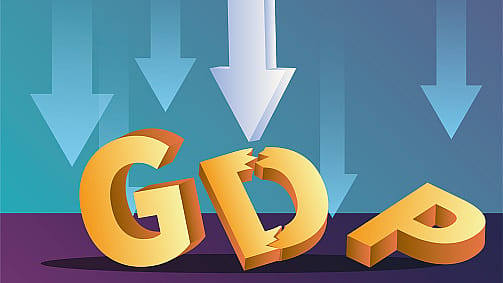India Ratings cuts FY23 GDP growth forecast to 6.9%
ADVERTISEMENT

India Ratings and Research (Ind-Ra) has lowered its GDP growth forecast for FY23 to 6.9% from its earlier forecast of 7.0%.
On a quarterly basis, Ind-Ra expects the growth to decline to 7.2%, 4.0% and 4.1% in Q2 FY23, Q3 FY23 and Q4 FY23, respectively.
Although the quarterly trends in GDP so far have been following the ebbs and flows of the pandemic, Ind-Ra believes FY24 onwards they are likely to get normalised without new shock. "Yet recovering the lost output due to Covid-19 will be a long haul. Ind-Ra's estimate shows that even if GDP grows at 7.6% every year after FY23, then also India would be able to catch up with pre-pandemic trend growth only by FY35," says Sunil Kumar Sinha, principal economist, Ind-Ra.
This comes hours after Fitch Ratings slashed India's GDP growth forecast to 7% in the financial year ending March 2023 from 7.8% previously due to elevated inflation and tighter monetary policy.
Despite private final consumption expenditure (PFCE) and gross fixed capital formation (GFCF) growth coming in better than its expectation in the first quarter of FY23, Ind-Ra expects the slowdown in the growth of government final consumption expenditure (GFCE) and worsening of net exports to weigh on the FY23 GDP growth.
While the high frequency indicators do not show a clear picture, the domestic economic activity compared to the rest of the world has shown more resilience. PFCE, the main driver of the economy, grew 25.9% year-on-year in Q1 FY23, albeit on a low base.
Ind-Ra expects the growth momentum to sustain, averaging around mid-single digit in the remaining quarters, mainly buoyed by the upcoming festival season. As a result, PFCE is expected to grow 10.2% year-on-year in FY23.
December 2025
The annual Fortune 500 India list, the definitive compendium of corporate performance, is out. This year, the cumulative revenue of the Fortune 500 India companies has breached $2 trillion for the first time. Plus, find out which are the Best B-schools in India.
However, 'K-shaped' recovery is neither allowing the consumption demand to become broad based nor helping the wage growth especially of the population that are part of the lower half of the income pyramid, says India ratings.
Household sector, which accounts for 44-45% of the gross value added, has witnessed nearly flat or negative growth in their real wages (adjusted for inflation) since FY19, says Ind-Ra. Wage growth in June 2022 in real terms stood at about negative 3.7% in urban areas and negative 1.6% in rural areas.
After PFCE, GFCF is the second-largest component (27.1%) of GDP from the demand side and it grew 20.1% year-on-year in Q1 FY23 due to the frontloading of government capex, says the ratings agency. Government capex grew at a robust 57.3% yoy in 1QFY23 and is having its spill-over effect on the core sector as well where segments such as cement are showing robust growth.
Ind-Ra expects the average retail and wholesale inflation to come in at 6.5% and 9.7%, respectively, in FY23. The key reasons for the elevated level of inflation are a combination of factors such as non-restoration of full supply chain disruption, caused first by Covid-19/Russia-Ukraine conflict, elevated global commodity prices, pass-through of rising input costs to output prices by manufacturers, weakening of rupee, and intermittent shocks due to the recalcitrant weather on the supply of fruits and vegetables.
Although global commodity prices especially of crude oil have softened lately from their peaks, pressure on inflation may come from the rise in prices of two main cereals namely wheat and rice, says the ratings agency. Wheat inflation is already in double digits, due to the unexpected heat wave which pulled down the wheat output this year and now the rice inflation rising due to the lower area sown under the paddy during the ongoing Kharif season.
Ind-Ra expects the current account deficit to widen to 3.4% of GDP in FY23 due to the ongoing domestic recovery and uncertain external demand.
